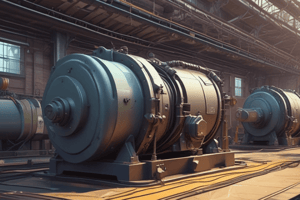Podcast
Questions and Answers
ما هي المرحلة المسؤولة عن نقل الكهرباء عبر خطوط فوقية أو كابلات تحت الأرض قبل وصولها إلى المحطات الفرعية المحلية؟
ما هي المرحلة المسؤولة عن نقل الكهرباء عبر خطوط فوقية أو كابلات تحت الأرض قبل وصولها إلى المحطات الفرعية المحلية؟
- نظام الاستخدام
- نظام النقل (correct)
- نظام التوزيع
- نظام التوليد
ما هي العنصر الذي يشير إلى إنشاء الطاقة الكهربائية من خلال مصادر مختلفة مثل الفحم والغاز الطبيعي والطاقة الشمسية؟
ما هي العنصر الذي يشير إلى إنشاء الطاقة الكهربائية من خلال مصادر مختلفة مثل الفحم والغاز الطبيعي والطاقة الشمسية؟
- نظام النقل
- نظام التوزيع
- نظام الاستخدام
- نظام التوليد (correct)
ما هو النظام المسؤول عن توصيل الكهرباء بجهد منخفض مباشرةً للمستهلكين عبر شبكات من الأسلاك والمحولات؟
ما هو النظام المسؤول عن توصيل الكهرباء بجهد منخفض مباشرةً للمستهلكين عبر شبكات من الأسلاك والمحولات؟
- نظام التوزيع (correct)
- نظام النقل
- نظام التوليد
- نظام الاستخدام
ما هو النظام الذي يمكن أن يشمل استخدام أجهزة كهربائية وأدوات للاستفادة من الطاقة الكهربائية؟
ما هو النظام الذي يمكن أن يشمل استخدام أجهزة كهربائية وأدوات للاستفادة من الطاقة الكهربائية؟
ما هو المفهوم الذي يشير إلى توليد طاقة كهربائية باستخدام مصادر مثل المحطات الشمسية والسدود الكهرومائية؟
ما هو المفهوم الذي يشير إلى توليد طاقة كهربائية باستخدام مصادر مثل المحطات الشمسية والسدود الكهرومائية؟
ما المصدر الرئيسي لإنتاج الطاقة على مستوى العالم والذي شهد انخفاضاً في نصيبه منذ أواخر القرن العشرين؟
ما المصدر الرئيسي لإنتاج الطاقة على مستوى العالم والذي شهد انخفاضاً في نصيبه منذ أواخر القرن العشرين؟
ما المصدر المستدام لإنتاج الكهرباء الذي يستمر في التوسع نظرًا للمخاوف البيئية والتقدم التكنولوجي؟
ما المصدر المستدام لإنتاج الكهرباء الذي يستمر في التوسع نظرًا للمخاوف البيئية والتقدم التكنولوجي؟
ما هو دور أجهزة التثبيت (Stabilizers) في أنظمة النقل للكهرباء؟
ما هو دور أجهزة التثبيت (Stabilizers) في أنظمة النقل للكهرباء؟
ما هو التكنولوجيا التي يعتمد عليها نظام توليد الطاقة للحصول على الكهرباء من خلال تفاعلات كيميائية؟
ما هو التكنولوجيا التي يعتمد عليها نظام توليد الطاقة للحصول على الكهرباء من خلال تفاعلات كيميائية؟
كيف يتم تخفيض جهد التيار عند وصول الكهرباء إلى منزل للاستخدام المنزلي؟
كيف يتم تخفيض جهد التيار عند وصول الكهرباء إلى منزل للاستخدام المنزلي؟
Flashcards are hidden until you start studying
Study Notes
Electric Power System Overview
The modern world is powered by electricity, an indispensable resource that enables us to live comfortably, work productively, and connect globally. At its core lies the electric power system—a vast network designed to produce, transmit, distribute, and utilize energy efficiently. Let's delve into each component of this complex yet essential infrastructure.
Introduction
An electric power system consists of four primary components working harmoniously together to deliver reliable electricity from generation to utilization across great distances. These components are the generation system, transmission system, distribution system, and utilization system:
-
Generation: This refers to the process of creating electrical energy through various sources such as coal, natural gas, nuclear reactors, wind turbines, solar panels, geothermal plants, hydroelectric dams, and others.
-
Transmission: Involves transporting high voltage electricity generated at power plants over large distances using overhead lines or underground cables before it reaches local substations. High voltages minimize energy loss during transportation and ensure efficient delivery of bulk quantities of electricity.
-
Distribution: Responsible for delivering low-voltage electricity directly to consumers via networks of wires and transformers. Local utility companies manage these systems within their service areas while maintaining strict safety standards.
-
Utilization: Also known as end-use, this involves consuming electricity produced by the system to fulfill our daily needs. This may encompass lighting homes, running appliances, powering industrial operations, and energizing communications equipment.
Generation System
Power generators harness diverse resources like water, wind, sunlight, chemical reactions, and heat to create electricity. Renewable technologies, including hydropower, wind, and solar, continue expanding due to environmental concerns and technological advancements. Fossil fuels still account for most global energy production; however, their share has been declining since the late 20th century due to sustainability efforts and rising costs.
Modern electric utilities must balance reliability with efficiency, cost control, and environmental considerations when planning new energy sources. A well-rounded mix of generating facilities helps achieve optimal performance across all key metrics.
Transmission Systems
High-voltage transmission lines carry electricity from locations where it was generated to substations near population centers or major industries, either above ground over long spans or buried in tunnels under urban environments. By increasing the voltage, transmission lines reduce the amount of lost energy. To maintain stable voltage levels along transmission paths, specialized devices called stabilizers correct any fluctuations caused by changes in load or supply conditions.
Distribution Systems
Once electricity arrives at a substation serving a particular area, it passes through multiple transformers to step down the voltage gradually until reaching level suitable for household usage, typically 240 volts AC or DC. Distributed grids incorporate advanced metering infrastructure (AMI) and intelligent electronic devices to optimize operation and promote grid resiliency.
Utilization Systems
Consumers rely heavily on electricity to support nearly every facet of modern life, whether they realize it or not. As demands increase, so do challenges related to delivering enough electric power without compromising grid stability. Energy storage solutions and smart home technology can help address imbalances between varying consumption patterns and available electricity. Users directly benefit from investments made in generation, transmission, and distribution systems because better infrastructure enhances overall efficiency and ensures more dependable access to electricity.
In summary, understanding how the electric power system functions allows us to appreciate the complexity and interconnectedness inherent to widespread electrification. By embracing renewable sources, improving distribution, and investing intelligently, we can guarantee safe, sustainable, and affordable electricity for future generations.
Studying That Suits You
Use AI to generate personalized quizzes and flashcards to suit your learning preferences.




